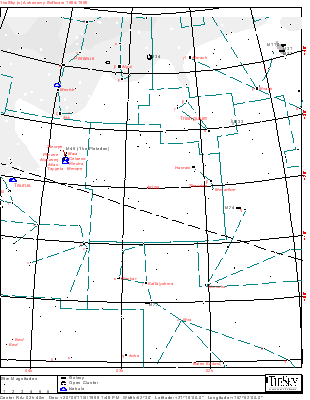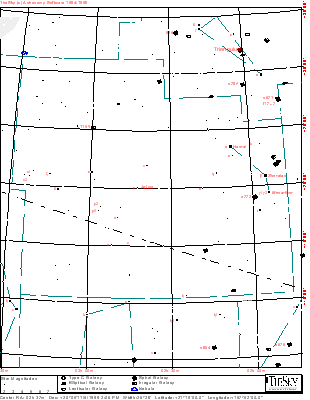
| Home | Deepsky Atlas | TheAstronews | Links | Solar System | ||||||

Hawaiian Astronomical SocietyConstellations: Aries -- The Ram who lost Helle |
||||||||||
Ino was the daughter of Cadmus, incurring the wrath of Hera for agreeing with Zeus to help raise Dionysus. Depending on the source, either she, Athamas, or both were driven mad through Hera's actions and killed their own children. Melicertes her son alone escaped by jumping into the sea ahead of Ino. Ino changed into a goddess, later helping Odysseus on his journey home. She is also known as Leucothea. Melicertes' body was carried by dolphins to his uncle Sisyphus of Corinth, who founded the Isthmian games in his honor. Melicertes may be linked with the Phoenician god Melqart (the Canaanite Baal of Tyre, sometimes called Baal Amon), which brings us to the second tradition.
Baal Amon (or Hammon) is derived from the Egyptian god Amon. Amon merged with the sun god Re (or Ra) as early as the late third millennium B.C. His cult was based in Thebes, the city ostensibly founded by Cadmus. Amon was usually depicted in human form, with the exception that he sometimes had a ram's head. His cult survived the attempt by Amenhotep IV (or Akhenaton) to replace his worship with the worship of Aton (the solar disk) in the 14th century B.C.. Worship of Amon declined sharply in the 1st century B.C., replaced by the cult of Isis, Osiris, and Horus.

Click the map for a 929x1200 version of the above. Click here for a map better suited for use in the field.

This a more detailed view of the constellation. The map displays stars to magnitude 10, and deepsky objects to magnitude 12. Click here for a map better suited for use in the field.
 9k JPEG NGC772 (Best 6) is a spiral galaxy located 1.3° ESE of Mesarthim (Gamma Arietis). Dreyer describes it as bright (mag. 10.3), quite large (7.5'x4.0'), round, with a gradually brighter middle. The galaxy rates a single "R" in the resolvability department. On this galaxy it means that the arms look mottled in a 12". An almost stellar nucleus is also possible. Increasing the magnification makes the arms disappear. 9k JPEG NGC772 (Best 6) is a spiral galaxy located 1.3° ESE of Mesarthim (Gamma Arietis). Dreyer describes it as bright (mag. 10.3), quite large (7.5'x4.0'), round, with a gradually brighter middle. The galaxy rates a single "R" in the resolvability department. On this galaxy it means that the arms look mottled in a 12". An almost stellar nucleus is also possible. Increasing the magnification makes the arms disappear.
Image is a 20 minute exposure by Jim Girard, taken through a 10" SCT (reduced fo f3.3), with an SBIG ST-7.
|
If you have any questions about the Hawaiian Astronomical Society
please
(link requires javascript).